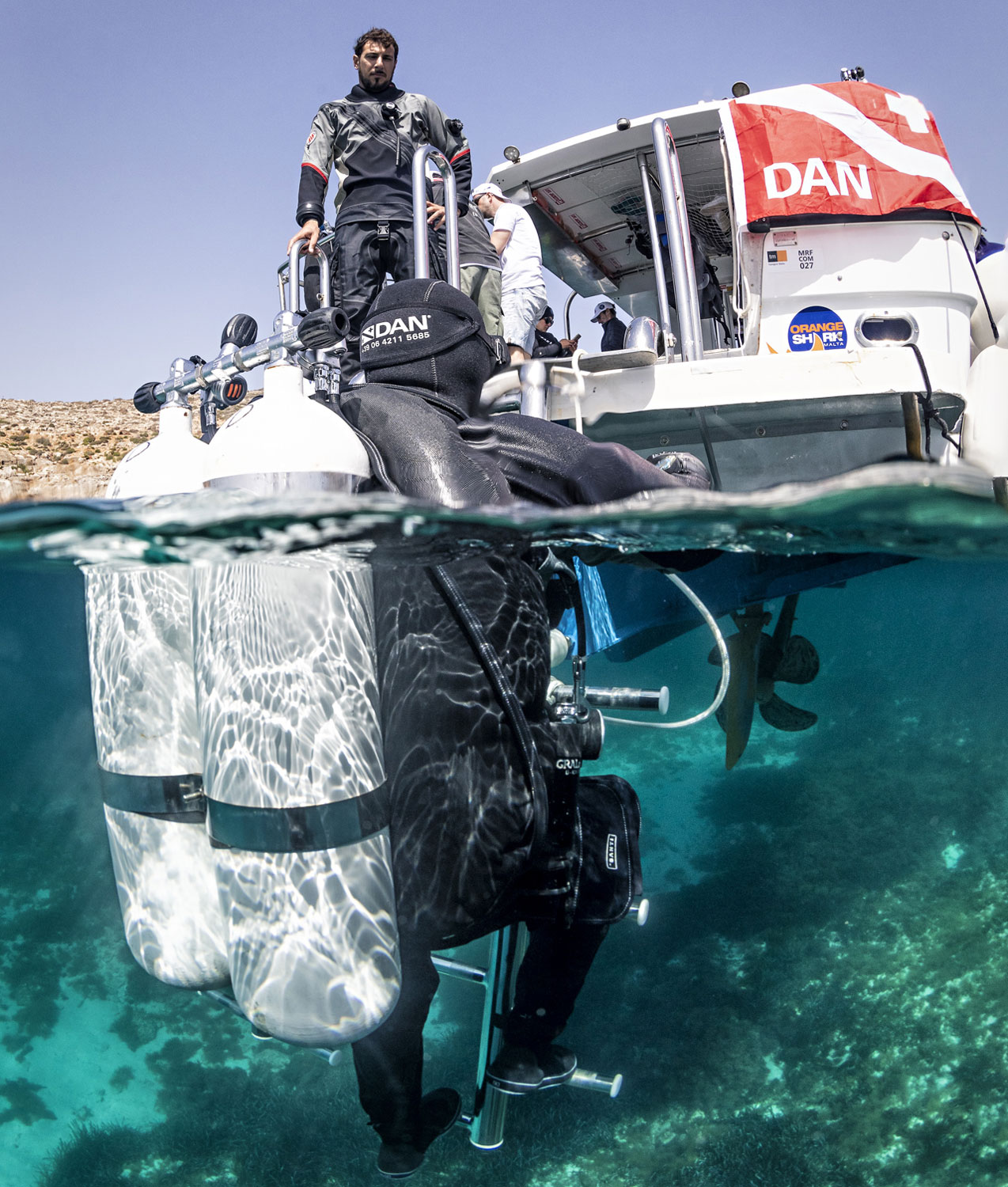Safety
Venetikkaiden turvallisuus
Useimmat alukselta sukeltaneet sukeltajat tietävät, että ennen veteen laskeutumista on tarkistettava, ettei ketään ole alla. Myös sukelluksen jälkeen sukeltajan on varmistuttava siitä, että ketään ei ole alapuolella, kun hän kiipeää takaisin alukselle tikkaita pitkin. Vaarana on nimittäin se, että hän putoaa tikkailta.
Sukeltajia muistutetaan usein näistä yllä mainituista kahdesta varotoimesta sukellusta edeltävän opastuksen aikana. Sukeltajille tulisi tällöin kertoa myös siitä, mitkä varusteet tulee riisua ennen alukselle kiipeämistä. Eri sukelluskohteissa ja eri aluksilla saattaa esiintyä eroja tämän suhteen. Käytössä olevat venetikkaat ja myös sukellukseen liittyvät yleiset olosuhteet eivät ole samanlaisia kaikkialla. Kun käytössä ovat esimerkiksi H-malliset tikkaat, sukeltaja joutuu mahdollisesti toteamaan, että hänen on riisuttava räpylänsä. Useammin käytössä olevat T-tikkaat taas ovat käyttäjäystävällisemmät, ja niitä kiivetessä voi pitää räpylät jalassa.

Vähemmän tietoa sukeltajilla taas on siitä, kuinka he voisivat välttää käsi- ja sormivammat kiivetessään ylös venetikkaita. Tästä asiasta ei myöskään mainita kovin usein sukellusta edeltävän opastuksen aikana. Merellä olosuhteet saattavat olla sellaiset, että tikkaiden kiipeäminen on vaikeampaa kuin muualla. Useimmiten sukeltajien täytyy myös selviytyä taitettavista irtotikkaista, vaikka joissakin aluksissa onkin kiinteät tikkaat.
Irtotikkaiden käytön ei tarvitse kuitenkaan olla ongelma, jos vain kykenet hahmottamaan, miten ne toimivat. Ensinnäkin on hyvä huomata, että tällaiset tikkaat kiinnitetään veneeseen yleensä saranan avulla. Näin tikkaat pääsevät liikkumaan ylös ja alas aaltojen mukana. Usein näitä saranoita ei voida lukita, joten tikkaat pääsevät liikkumaan, on niillä sitten sukeltaja tai ei. Voit ajatella tikkaita ikään kuin ne olisivat pähkinänsärkijä. Kuvittele, että pähkinänsärkijän toinen kahva on kiinnitetty paikoilleen, samalla kun sinä vedät toisesta kahvasta. Pähkinä halkeaa ilman että sinun tarvitsee käyttää paljon voimaa. Venetikkaat toimivat samalla tavalla.
Toisena kahvana toimii siis vene, ja toinen kahva on tikkaat. Kun tikkaat nousevat, silloin pähkinänsärkijä itse asiassa avautuu. (Jalkasi liikkuvat tällöin taaksepäin, kun seisot tikkailla.) Kun tikkaat sitten laskeutuvat taas takaisin alas, ei todellakaan ole hyvä, jos kätesi tai sormesi jäävät kahden liikkuvan osan väliin. Jos näin pääsee käymään, et pysty tässä tilanteessa vapauttamaan käsiäsi niihin kohdistuvan paineen alta, koska kehosi koko paino on tikkailla. Näin ollen lopputuloksena on sormien tai käsien vaurioituminen tai ehkä jopa amputaatio! Tämä sama koskee tikkaiden kaikkia liikkuvia osia.

Yllä mainitut vammat voidaan välttää: muista vain katsoa huolellisesti, minne asetat kätesi. Joskus tämä on helpommin sanottu kuin tehty, koska aallokko voi tehdä alukseen kiipeämisestä haastavaa. Et ehkä kiinnitä kovinkaan paljon huomiota siihen, missä kätesi ovat. Tikkaiden suunnittelu voi vähentää käsi- ja sormivammojen riskiä, ja sukelluskeskuksia myös rohkaistaan tekemään perusteellinen riskiarviointi ja varmistamaan, että heidän tikkaansa ovat mahdollisimman turvalliset.
Lopuksi lausumme vielä muutaman sanan päähän kohdistuvista vammoista. Niitä tulee harvoin, mutta kannattaa olla varovainen silloin, kun aallot ovat korkeita. Tällöin tikkaat nousevat melko korkealle ja iskeytyvät sitten veteen aaltojen laskeutuessa. Pidä huoli siitä, että et sillä hetkellä ole tikkaiden alla. Tämäkin voi olla haastavaa silloin, kun voimakkaat pohjavirtaukset työntävät sinua tikkaita kohti. Älä koskaan nouse pintaan liian lähellä tikkaita, vaikka mieleen saattaisikin tulla, että tällöin niihin on helpompi tarttua. Koko päiväsi saattaa mennä pilalle tämän seurauksena.
Tietoa artikkelin kirjoittajasta
Guy Thomas on kokenut sukellus- ja ensiapukouluttajien opettaja. Hän työskentelee kokoaikaisena turvallisuusohjelmien johtajana DAN Europella. Työssään hän vastaa DAN Europen turvallisuusaloitteiden kehittämisestä ja toteuttamisesta. Hän on myös jäsenenä Italian Punaisen Ristin erikoispelastusryhmässä. Samoin hän toimii pelastusuimarina/sukelluslääkintämiehenä Italian valtiollisen poliisin SAR-helikopteritoiminnassa (etsintä- ja pelastustoiminta).
Kääntäjä: Marianna Rantanen

